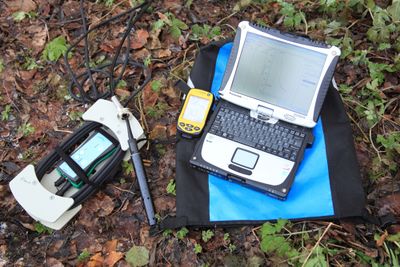Discharge - tracer (Sommer TQ-System)
previously advertised as "FlowTracer"
Parameter to be measured:
discharge
Method:
tracer dilution, sensors for conductivity (NaCl) and fluorescence (Uranine) available
Equipment:
- probes for conductivity or fluorescence
- Bluetooth transmitter
- USB Bluetooth adaptor
- various calibration vessels and pipette
- software TQ-commander for Windows OR Windows Mobile
- Laptop or Windows Mobile device (not included)
Advantages:
- comfortable usage on computer/PDA
- wireless connection between computer/PDA and probes up to 120 m (specification of manufacturer, field tests showed values of 40 to 200 m)
- BT-modules run on ordinary AA-batteries, but can also be charged with charger within the module
- guided measurement process in software, real-time visualisation of concentration and computation of discharge
- post-processing options in software (e.g. variant base concentration); handling and re-use of calibration coefficients
Disadvantages:
- only one software variant (Windows OR Windows Mobile) included, the other option must be purchased extra
the supplied software TQ-Commander did not recognize the internal Bluetooth device in a Panasonic Toughbook but required the USB-Bluetooth adaptor (included in the package)fixed with ver1.1.10- the AutoConnect-Procedure is very unreliable: sometimes, everything worked like a charm, sometimes only one of the two probes was found, in other occasions none. Manually searching and connecting to the probes usually fixes this.
- During the calibration procedure in the TQ-Commander, the software often does not accept the readings when only small (but still detectable!) changes in concentration occur. Since the TQ-commander does not allow modifying the injection amount, you can only abort and restart the procedure (meaning you have to flush and refill you calibration vessel with river water again)
- the charge jack of the probes cannot be accessed when the device is in the cradle (coil of probe cable). If you fumble it out, check the correct connection with the cable of the probe when putting it back.
- The carrying cases are quite bulky and could be downsized.
- Software for mobile device (ver. 1.0.5.5) does no plotting and is unstable (error message at end, loss of data, see below).
What to watch out for:
- in a solitary test, the Bluetooth connection with one probe using the external BT-adaptor remained active till 160 m of distance (unobstructed line of sight). Resuming the broken connection required reducing the distance to 20 m again or was not possible at all
- although using the internal BT-device may be more comfortable than using the USB-BT-adaptor, in the case of the Panasonic Toughbook the USB-BT-adaptor seemed to have superior range (inferred from the detectability of the probes in the standard BT-pairing)
- the fluorescence sensors are ~20% more bulky than their conductivity brothers (cradle, coil, etc.)
- for baseline use, you'll need the sensors, the BT-module and the software. Everything else is optional (cases, calibration kit, chargers, ...) and can be replaced by standard lab equipment to cut costs.
- Sometimes, during use with mobile software, the measurement is performed and a result displayed. Then, the device displays "Saving data" and hangs or idles for long. However, when trying to sync the data, none are found or substituted by an older measurement. To avoid this
- Re-open the software after each measurement
- Synchronize often
- If still data is lost, don't restart TQ-Commander. Look for folder "Temp_Data" in the programs installation directory. Safe its contents. Look for a file M_* created at the time of you measurement. Open it with a standard text editor to check if it contains the missing data. Create a copy the file Database.tgz (this is a compressed file, rename to zip, if necessary) e.g. as D2.tgz . Copy the found M_* into D2.tgz. Modify the file MeasurementManager.xml from D2.tgz by adding an extra measurement block for you restore measurement by using the hash-code following the "M_" in its file name. Synchronize with PC-Software.
- The measurement of conductivity is apparently coupled/correncted with the temperature measurements. When the latter fails, it may also affect the former. If you don't get proper temperature readings, check connector between BT-unit and probe. Pins there tend to detach - re-solder them.
Problems/Questions:
- the manual advises specific orientation of the USB-BT-adaptor to maximize the stability of the connection. An analogous specification for the orientation of the probes would be valuable
Price:
- conductivity set with 2 probes, PC-software: ~5600 € (10/2011, Germany)
- Windows-Mobile software: ~1200 € (8/2012, Germany)
- fluorescence sensors (no BT-modules), calibration kit and cases ~8500 € (9/2013, Germany)
Links
Projects that used the above equipment: [1]
Other related web sites:
